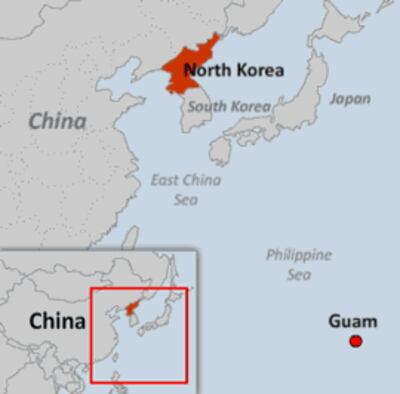Modern missiles displayed at a recent North Korean military parade may represent advances in strategic reach for the reclusive Stalinist state, but some may be less threatening than they now appear, according to experts.
One missile, the intermediate-range Musudan, has an estimated range of from 2,500-4,000 km (1,550 to 2,490 miles) and can hit U.S. bases on the island of Guam, the experts agreed.
The missiles, the Musudan and an apparently improved surface-to-air missile (SAM) system, were exhibited at a parade in Pyongyang on Oct. 10 marking the 65th birthday of the ruling Korean Workers Party.
Kim Jong Un, heir-apparent as North Korea’s next top leader and son of the country’s present leader, Kim Jong Il, observed from a reviewing stand along with other senior political and military figures as the parade passed by.
The Musudan, publicly photographed for the first time at the parade, is a “highly deployable, highly mobile missile” carried and launched from truck-sized carriers, said Bruce Bechtol, an associate professor of political science at Texas-based Angelo State University.
Because of the Musudan’s mobility, launches of the missile are difficult to anticipate and defend against, said Bechtol, author of the new book Defiant Failed State: the North Korean Threat to International Security.
And the missiles’ range “means they can hit Guam,” Bechtol said.
“Guam is U.S. territory,” Bechtol said. “And it’s where we deploy a lot of the U.S. air power that would fly to the Korean peninsula in case of war.”
With an estimated 200 of the missiles already deployed and capable of carrying a chemical warhead, the Musudan can be fired “in volleys,” Bechtol said.
Leap, or fake?

Richard Fisher, an arms expert and senior fellow at the Virginia-based International Assessment and Strategy Center, said that the SAM guidance and missile system on display at the Oct. 10 parade represents a “huge leap in anti-aircraft missile technology.”
The missiles’ radar-based guidance system is difficult to jam, Fisher said, and “raises the job of attacking North Korea’s nuclear and missile emplacements to a far greater level.”
“Once this missile system is widely deployed, there is simply no way that U.S. or South Korean aircraft can get close to these targets without risking substantial casualties.”
While noting that two SAM missile guidance systems and six missile-carrying trucks, for a total of 18 missiles, were exhibited at the parade, Fisher said, “This could be a pre-production batch. It could be a batch for testing. We don’t know.”
Joseph Bermudez, a senior analyst for the London-based Jane’s Information Group, agreed, adding, “North Korea is aware that we watch them pretty closely.”
“So it would not be, and has not been, beyond the North Koreans to put things in the parade that aren’t what they seem to be—that might not be production versions of things.”
North Korean missiles may have been placed in the parade “because they were failed prototypes, or were built specifically so as to be part of a deception plan to throw off what we are trying to do to track them,” Bermudez said.
Signal of support
Fisher noted that China had sent a “high-level delegation” to observe the Oct. 10 parade from the reviewing stand together with top North Korean leaders.
“China has publicly blessed Kim Jong Il’s chosen successor,” Fisher said.
“China has signaled both its political and military support for a nuclear-armed dictatorship to survive in North Korea for another generation … and brings closer the day that South Korea and, in turn, Japan will have to make the fateful decision to build their own nuclear deterrent.”
North Korea has sold missiles, missile components, and technology to several countries, including Iran, according to a 2009 International Crisis Group report, “North Korea’s Nuclear and Missile Programs,” authored by Daniel Pinkston, an expert on the country’s weapons programs.
“Its missile program has been an important source of hard currency and a symbol of national power that the leadership exploits for internal political control,” the report said.
Reported in Washington by Richard Finney.
